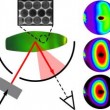Seeing the Light? Making Sense of Disorder in Polymer Opals
The iridescent colours of natural opals have fascinated people for thousands of years. It is interesting, however, that the colours we see are generated only by diffraction of light between the ordered planes of atoms which make up the structures. In order to reproduce this effect in artificial systems and to allow such opal characteristics to be applied to, for example, flexible materials such as clothing or packaging, research into synthetic opals has gained momentum in the last decades.
The diffraction of light from opal materials is very sensitive to the angle of reflection from the atomic planes within these materials, and variations in these angles can occur as a result of defects within the crystal structure. In order to fully characterize and understand the optical properties of synthesized opals it is important to be able to completely measure this angle-dependence; however, previously a technique to do this has been lacking.

Now, Andrew I. Haines and Jeremy J. Baumberg et al. have described a new way of measuring the three-dimensional angular scattering of light from nanostructures (hyperspectral goniometry technique), and use it to show that scattering from polymer opals, composed of ordered polymer nanospheres, is anisotropic. Specifically, light is scattered more broadly in the direction perpendicular to sample processing. They find that this effect is the result of chain defects, i.e., the presence of extra lines of polymer nanospheres, in the polymer-opal films tested; and that the enhanced colour observed when the structures are more highly ordered is due to an increased effective refractive-index contrast.
Furthermore, by doping these synthetic opal structures with light-absorbing carbon nanoparticles they discovered the colour saturation could be greatly improved as the nanoparticles absorb multiply scattered light so lower the background scattering without affecting the resonant scattering.
This research was reported in Advanced Optical Materials, a new section in Advanced Materials dedicated to breakthrough discoveries and fundamental research in photonics, plasmonics, metamaterials, and more, covering all aspects of light-matter interactions.
Source: Nanotechnology Now
- 311 reads




